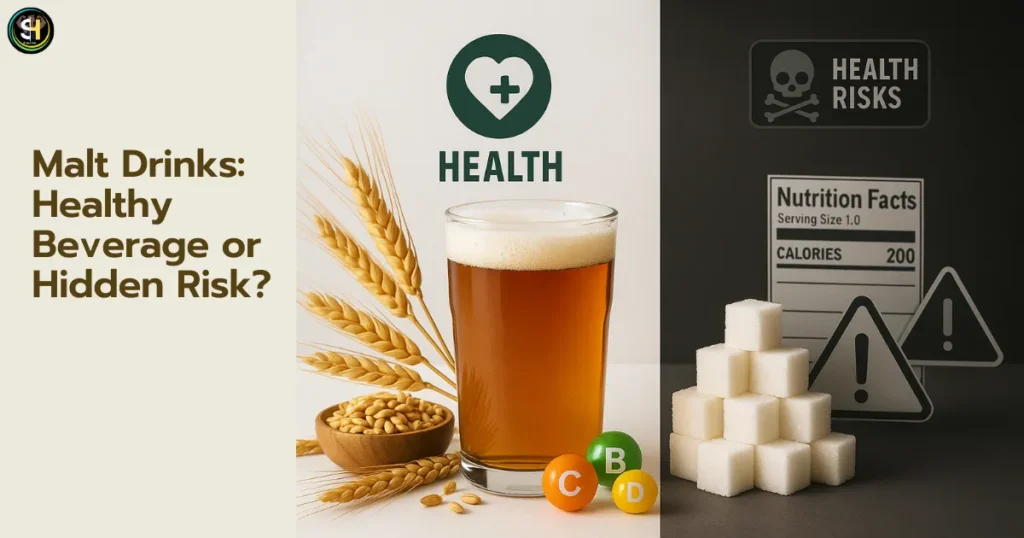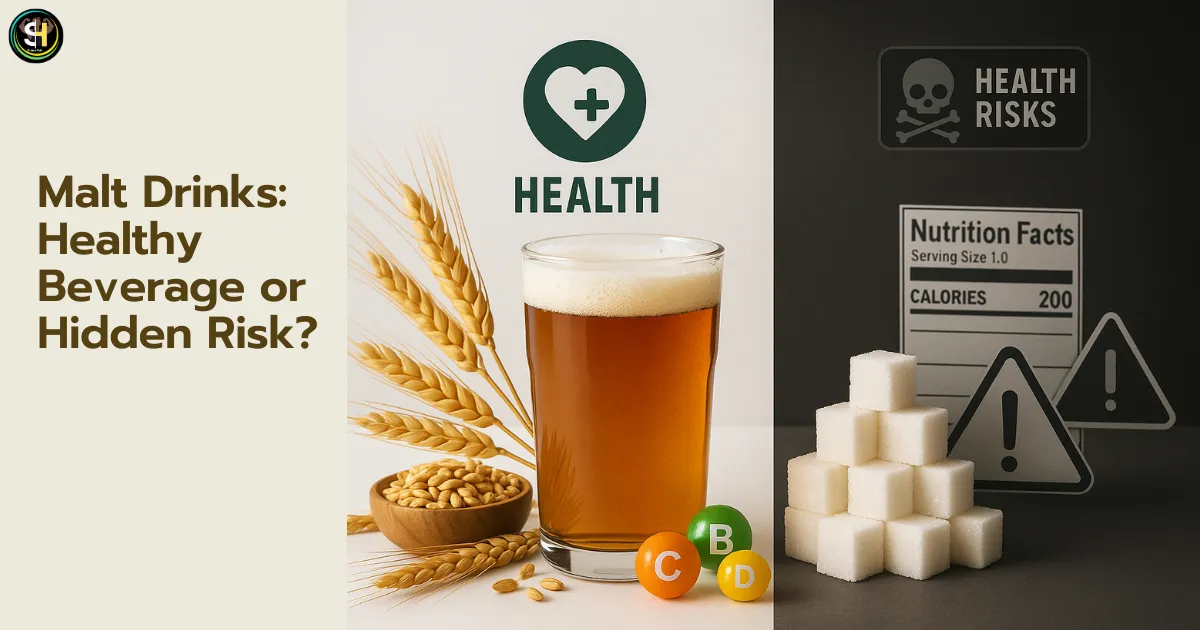
Malt drinks have gained considerable popularity worldwide, promoted as nourishing beverages rich in vitamins, minerals, and energy. But beneath their appealing flavor and nutritional claims lies an ongoing debate: are malt drinks genuinely healthy, or do they carry hidden risks that consumers should be aware of?
This comprehensive article investigates the benefits and potential health risks of malt drinks, based on current scientific evidence and expert insights. With a balanced approach backed by EEAT (Experience, Expertise, Authoritativeness, and Trustworthiness), we explore the ingredients, nutritional value, marketing strategies, and their impact on public health to answer the critical question: are malt drinks a healthy beverage or a hidden risk?
What Are Malt Drinks?
Malt drinks are beverages produced from malted barley or other grains through a process that involves soaking, germinating, and drying. The result is malt extract, which contains a natural source of sugars, amino acids, and vitamins.
There are two primary types of malt drinks:
- Non-alcoholic malt beverages (commonly marketed as health drinks or energy boosters)
- Alcoholic malt beverages (like malt beer or certain flavored alcoholic drinks)
This article focuses primarily on non-alcoholic malt drinks, widely consumed by children, teens, and health-conscious adults.
Read This Also : Should You Rely on Split Pea Soup for Complete Protein
Nutritional Composition of Malt Drinks
Malt drinks are often marketed as nutrient-rich, containing:
- B-vitamins (B1, B2, B3, B6, and B12)
- Calcium
- Iron
- Potassium
- Amino acids
- Antioxidants
However, most commercial malt drinks also contain:
- High amounts of added sugar
- Artificial flavorings and preservatives
- Calories with limited fiber
- Coloring agents
Depending on the brand, a 330ml serving of a malt drink can contain up to 35 grams of sugar, which is nearly 7 teaspoons — exceeding the WHO’s daily recommended limit for adults and children.
Health Benefits of Malt Drinks
Despite their sugar content, some potential health benefits of malt drinks exist when consumed in moderation.
1. Energy Boost
Malt is a natural source of complex carbohydrates, which provide quick and sustained energy. This makes malt drinks popular among athletes, manual laborers, and students.
2. B-Vitamin Support
Many malt drinks are fortified with B vitamins that support:
- Metabolism
- Red blood cell formation
- Brain function
- Energy production
3. Bone Health
Some variants are enriched with calcium and vitamin D, contributing to better bone and dental health, especially in growing children.
4. Digestive Aid
Traditional malt extract has been used as a mild laxative and digestive aid due to its soluble fiber content, although this benefit is often reduced in heavily processed drinks.
Hidden Risks of Malt Drinks
While malt drinks can offer short-term benefits, frequent or excessive consumption carries several health risks, particularly due to sugar content and misleading marketing.
1. High Sugar Content and Risk of Obesity
Most commercial malt drinks are sugar-laden. Overconsumption can contribute to:
- Weight gain
- Obesity
- Insulin resistance
- Type 2 diabetes
The American Heart Association recommends limiting added sugars to 25g/day for women and 36g/day for men — less than a single bottle of some malt drinks.
2. Tooth Decay
Malt drinks are acidic and sugary — a perfect combination for dental caries, especially among children.
3. Hidden Caffeine in Some Variants
Certain malt drinks are marketed as energy boosters and may contain hidden caffeine or stimulants, which can raise blood pressure and increase anxiety in sensitive individuals.
4. Artificial Additives
Colorants like caramel coloring (E150c or E150d) used in some brands have been linked to carcinogenic compounds in animal studies. Preservatives and synthetic flavorings may also trigger allergic reactions or digestive disturbances in sensitive populations.
5. Marketing Misrepresentation
Brands often use health halos — phrases like “nutritious,” “natural energy,” or “vitamin-rich” — to promote their drinks, downplaying sugar content or lack of fiber and protein.
Malt Drinks and Children: A Growing Concern
Children are one of the biggest consumer segments for malt drinks, especially in countries like India, Nigeria, the Philippines, and the UAE.
However, pediatric nutrition experts warn that:
- High sugar levels in these drinks are contributing to childhood obesity epidemics.
- Malt drinks may replace healthy meals due to their “filling” nature, but they lack essential macronutrients.
- Repeated exposure to sweetened drinks reshapes taste preferences, increasing cravings for sugary foods later in life.
Expert Insight:
Dr. Ruchi Sharma, Pediatric Nutritionist (India):
“Malt-based drinks are not a nutritional necessity for children. In fact, their overuse is a silent threat masked under health claims. Balanced whole foods always take priority.”
Regional and Global Trends
India:
Malt-based drinks like Bournvita, Horlicks, and Complan are household names. But in recent years, these brands have faced criticism and legal scrutiny for misleading advertisements and high sugar levels.
Middle East & Africa:
Brands like Vitamalt and Malta Guinness dominate the malt drink space, often promoted as alcohol-free social alternatives. However, health campaigns are beginning to raise red flags on their sugar impact.
Western Markets:
Malt drinks are niche but gaining popularity among athletes and fitness communities, particularly non-alcoholic craft malt beverages.
Regulatory Oversight and Labeling Issues
Malt drinks often fall into a gray regulatory zone, especially in countries where they are classified as nutritional supplements rather than food products.
Common regulatory gaps include:
- Inconsistent labeling of sugar content
- Lack of caffeine disclosure
- Ambiguous health claims without clinical evidence
In 2023, several brands were fined in India and the UK for failing to clearly communicate sugar levels and using unverified scientific claims in ads.
How to Choose a Healthy Malt Drink
If you enjoy malt drinks, here’s how to make smarter choices:
✅ Check the Sugar Content
Always read the nutrition label. Choose drinks with <5g of sugar per 100ml or consider unsweetened versions.
✅ Prefer Whole-Grain-Based or Organic Options
These may retain more fiber, protein, and micronutrients with fewer additives.
✅ Look for Added Nutrients Without Added Caffeine
If using for children or teens, ensure the product is caffeine-free and offers genuine micronutrient benefits.
✅ Limit Frequency and Portion Size
Use malt drinks as occasional supplements, not daily meal replacements.
Are Homemade Malt Drinks a Better Option?
Absolutely. Homemade malt drinks give you full control over ingredients and sugar levels. You can make them with:
- Soaked and sprouted whole grains (barley or millet)
- Natural sweeteners (dates, honey)
- Dairy or plant-based milk
- Nuts or seeds for protein
These can provide a nutrient-rich, fiber-packed, lower-sugar alternative to store-bought malt drinks.
Final Verdict: Healthy Beverage or Hidden Risk?
✅ Yes, malt drinks can be part of a healthy diet when consumed occasionally and chosen wisely.
However…
⚠️ Most commercial variants on the market are not as healthy as marketed. Their high sugar, artificial additives, and exaggerated health claims make them closer to a soft drink than a health supplement.
Consumers, especially parents, need to look beyond branding and focus on real nutrition. Health authorities should enforce stricter labeling laws and discourage misleading marketing practices.
Frequently Asked Questions (FAQs)
❓ Are malt drinks good for children?
Only in moderation. Avoid sugar-laden variants and never replace meals with them.
❓ Can diabetics drink malt beverages?
Caution is advised. Most malt drinks cause blood sugar spikes. Look for diabetic-friendly or unsweetened versions if needed.
❓ Is there alcohol in malt drinks?
Non-alcoholic malt drinks typically contain less than 0.5% alcohol, but always check labels.
❓ Can malt drinks help gain weight?
Yes — due to their high-calorie and sugar content, they can support weight gain in underweight individuals, but healthier options should still be prioritized.
Conclusion
Malt drinks walk a thin line between nourishment and indulgence. While rooted in tradition and nutrition science, today’s commercial formulations often mask a highly processed, sugary beverage under the guise of health.
By staying informed and choosing wisely, consumers can enjoy the benefits of malt without falling into the trap of hidden risks.
References
This resource offers a detailed nutritional breakdown of malt drinks, highlighting their vitamin and mineral content, as well as their sugar and calorie levels. It serves as a valuable reference for understanding the nutritional profile of malt beverages.
This article discusses the potential health effects of malt beverages, including their impact on blood pressure and overall health considerations. It provides a balanced perspective on the consumption of malt drinks.
